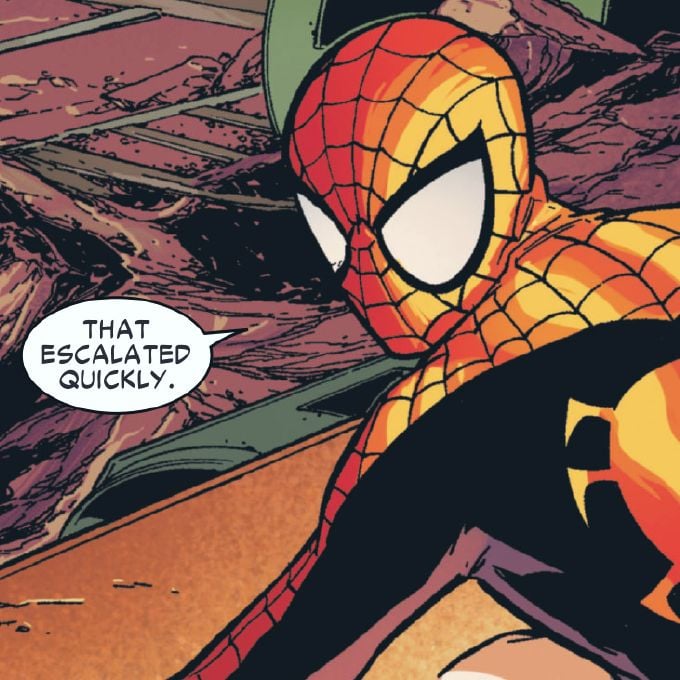- cross-posted to:
- [email protected]
- cross-posted to:
- [email protected]
Found via the author’s Mastodon Post
Generally, the media has focused on the (mainly) men whose names and desires were taken from the company’s subscriber database and shared with the world. […] Ashley Madison was never really about that. Avid Life Media, its parent company, wasn’t in the business of sex, it was in the business of bots. Its site became a prototype for what social media platforms such as Facebook are becoming: places so packed with AI-generated nonsense that they feel like spam cages, or information prisons where the only messages that get through are auto-generated ads.
I think a lot of dating sites are using bots or other means to push engagement at this point since online dating for women can be summed up like this:

Fuck now I want a hot dog
How’d you get this picture of my Grindr DMs?
I remember online dating looking more like this from a male perspective.
Back when I was in online dating (I got married in 2010, so it has been a very long time), this is how it seemed to work in the hetero arena:
- Women (by which I mean, legitimate accounts from women who were actually looking for dates): Get 1,000,000 messages, approximately 999,900 of which are dick pics.
- Men: See 1,000,000 ads, of which about 3 are legitimate people looking for dates.
So, both could be true in relation to the image.
I remember a guy once telling me that basically you have to respond to EVERY AD and hope something sticks. I never did that, and I felt bad for what the women must have had to deal with when I heard that. I had very limited success - dates with, at most, two or three women, and none of those really went anywhere. I ended up marrying someone from work instead.
Straight dating online is like trying to find drinkable water in a crisis situation; women are stranded in the ocean, and men are stranded in the desert.
Dude. You got 3 whole messages?
Some kind of miracle, I know. Actually I got more messages, but many of them were either spam or never even made it to a date.
Both definitely are true. I don’t mean to indicate that one view is right. One feeds into the other. This is just he natural outcome when one sex is a sexual selector and one is not. I don’t envy either group online dating, but for different reasons.
Had a buddy and told him to use a throw away card. He said it will be fine. I told him not to use his main email address. He had access to fifty or more domains he could have used. He said no it will be fine. The day it broke he called me and I just laughed at him. I had already grabbed the database and had it loaded up where it could be queried. He was there and so were so many other people in our small town. They used their local ISP email which I was the administrator for at that time. Most used their regular cards with their name on it. Many of the payment methods listed though were reloadable throw away cards.
The business model to require paid credits in order to interact with bots is in my opinion a thing of sheer bastardry.
Apparently, this is how it works: (*)
Women were on the site for free, men were required to pay for and use credits in order to interact with women.
It appears that there weren’t anywhere near the numbers of women claimed by the company. Instead bots would communicate with men, using their credits in the process.
(*) I say works, because apparently the company still exists today and I’m not aware if they ever admitted to using bots, let alone discontinuing their use. The Netflix series goes into detail, which is where I got this understanding from.
Disclaimer: I’m not a customer, have never been one and my comments are based on a single source as described above.
Completely off-topic: I really enjoy the way you express yourself. Do you write a lot? Your text is just very easily consumable, yet not dumbed-down.
Thank you for your kind words.
I have been writing for most of my life. You can for example read (a copy of) the Alt.Best.Of.Internet FAQ I wrote in 1994. [1]
[1] https://www.itmaze.com.au/articles/aboi-faq
I tend to write how I speak and attempt to create enough context so a casual reader on the topic can come away with something whilst still discussing the complexity for someone more versed in the subject.
I have written articles about identity theft, authentication over the phone, as well as other technology issues relevant to the public at large. [2]
[3] https://github.com/ITmaze/articles
I also write a weekly article about the hobby of amateur radio and have done so for over 13 years. It’s published as an audio podcast, with email, video and Morse code versions. [4]
[4] https://podcasts.vk6flab.com/
As for the suggestion of a TED talk, I’ve considered it, but haven’t found a topic worthy of the platform.
As a radio amateur I publish using my callsign, VK6FLAB, as an IT professional, it’s under my company, ITmaze.
Some other articles:
use Netiquette
Wow, I haven’t heard that in long time.
I re-read it and loved the: “Always fasten your seatbelt on the Information Highway”, but I’m fairly certain that Malinda McColl wrote it (as part of the mini FAQ on which I expanded with her blessing).
You can for example read (a copy of) the Alt.Best.Of.Internet FAQ I wrote in 1994.
The elders🙇♂️
Hey, I resemble that remark!
73 🙂
🛜5️⃣9️⃣9️⃣ and 7️⃣3️⃣ to both of you!
No callsign though… (yet?)
It’s published as an audio podcast, with email, video and Morse code versions.
Any chance of a SSTV version? 😂
As it happens it’s already on my radar.
That said, I’m not convinced that the YouTube video version is worthy of being transmitted on SSTV, given that it’s a waterfall display of the audio.
I’d totally watch their Ted Talk
That’s very kind.
You can hear my voice any time. [1]
[1] https://podcasts.vk6flab.com/
That said, I have stood on stage many times and if I could come up with a topic worthy of the TED talk platform I’d be game.
So, as someone who has used the Internet since its very earliest days, what would you say about what the Internet is like today versus back then? Was it better? Worse? Any major online events that you can recall from that period?
I grew up at the very tail end of the old forums and certainly after the decline and death of old school chat rooms. Most of them died or went inactive while I was in high school/college. The version of the internet older adults used is almost alien to me.
Hell, today’s Internet is on its way to being alien too.
I absolutely love the question and I’m going to attempt to answer it in a way that is not a reminiscing by an “old” internet citizen, rather some of the magic and wonder that I have been fortunate enough to experience.
My first time really connecting to the Internet was in 1990. I didn’t have my own account, so with permission I used the account that belonged to my boss at the time, Brian Murphy. He was a statistician and wine maker who had employed me to convert a statistics program (NANOVA) he wrote for a mainframe into something that could run on a desktop spreadsheet program that was new and exciting at the time, Wingz.
At the time the way “the Internet” worked was much more fragmented than the almost integrated experience we have today. Protocols (ways of getting information) like “telnet”[1], “ftp”[2] and “finger”[3] were how you got around, using programs that only knew how to do one thing. All of it was text-only. If you’ve heard of “gopher”[4], it didn’t exist yet. The “Wide Area Information Server”[5] (WAIS), had only just been invented but hadn’t made it to my desk.
You used text only email much like today, but addressing required that you knew how to get your message from your system to the recipient, using a so-called bang path [6] addressing scheme. This was not fun, but it got the job done. You could use tools like “finger” to determine how to get email to a person, which was a great help, but still was non-trivial. It’s like putting an address on an envelope that says, send this message from Perth, to Kalgoorlie, then to Adelaide, then to Sydney, then to Ultimo, then to Harris Street, then to number 500.
Much simpler was to use “Usenet News”[7], a global messaging system where you connected to your local news server, participated in discussion, whilst behind the scenes your messages would be shared with other news servers which were doing the same.
So, I’m sitting at my desk in Brian’s office with a brand new Apple Macintosh SE/30. This is leading edge hardware. I have a text-window open that is emulating a terminal (probably a VT220[8]), using telnet I’m connected to the local VAX cluster[9] that is running (among other things) our local news server.
I am not certain, but I think that this is my first ever message. It’s 4 September 1990 and I’m having an issue with MPW Pascal and the piles of paper documentation surrounding me had no answers. There is no “Google” or anything like it at this point, so I had to find answers elsewhere.
I found the message in one of the “comp” groups[10], “comp.sys.mac.programmer”, as opposed to an “alt” group[11] like alt.best.of.internet. These names are how you navigated the massive hierarchy of information that Usenet represents. Just like with domain names today, you specify the name by adding more dot names.
In today’s terms this could be expressed as a Lemmy community or a Reddit sub. And just like with those today, each Usenet group was a community with its “in” jokes, people who knew what they were talking about and those who didn’t, the whole enchilada.
Anyway, I posted to the group and asked a question about how to achieve the thing I wanted to fix. I went home and the next day I had a reply … from Brazil, where they too had discovered this issue and had found a solution.
It … blew … my … mind.
This started me on the journey I’m still on today. There is plenty more to tell to cover the 34 years since then. Perhaps a story for another day.
I debated providing links to some of the things I mention, but given that links didn’t exist in 1990, finding information was HARD, I thought it would be a nice ‘meta’ joke to include them.
Today I am going to do something much more mundane, set-up a backup job for a virtual server that was cloned from an older system, running a web-site and database on a cloud provider platform that I can use and access as-if it’s sitting on my desk while it is thousands of kilometres away. If my fingers were small enough, I could do this from my mobile phone.
So, yeah, things have changed.
o
[1] https://en.wikipedia.org/wiki/Telnet
[2] https://en.wikipedia.org/wiki/File_Transfer_Protocol
[3] https://en.wikipedia.org/wiki/Finger_(protocol)
[4] https://en.wikipedia.org/wiki/Gopher_(protocol)
[5] https://en.wikipedia.org/wiki/Wide_area_information_server
[6] https://en.wikipedia.org/wiki/UUCP#Bang_path
[7] https://en.wikipedia.org/wiki/Usenet
[8] https://en.wikipedia.org/wiki/VT220
[9] https://en.wikipedia.org/wiki/VMScluster
[10] https://en.wikipedia.org/wiki/Comp.*_hierarchy
[11] https://en.wikipedia.org/wiki/Alt.*_hierarchyThank you so much for this information. Your passion is contagious. I’m going to dive into all of these sources in the morning!
Have a wonderful day/evening/night!











